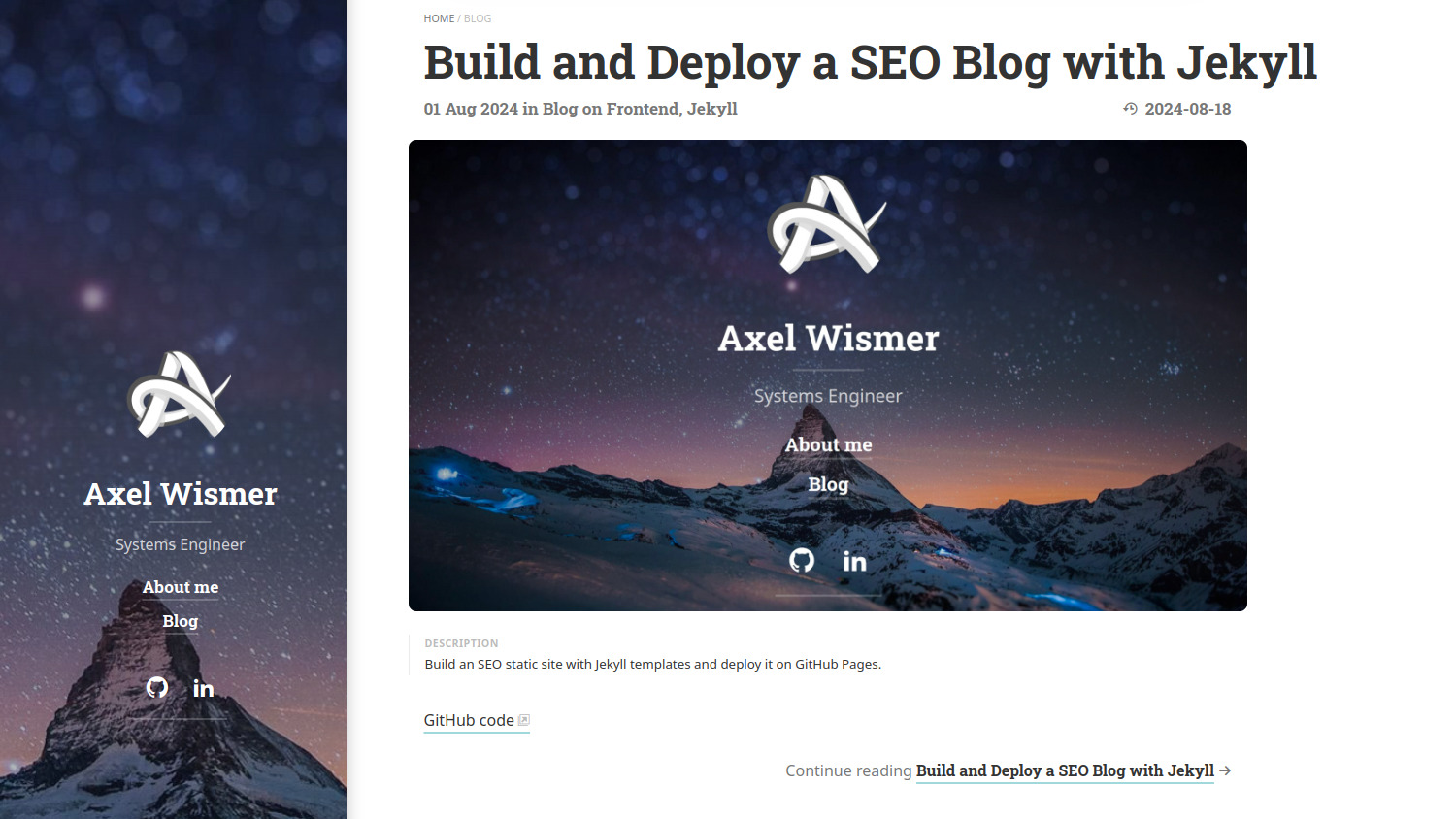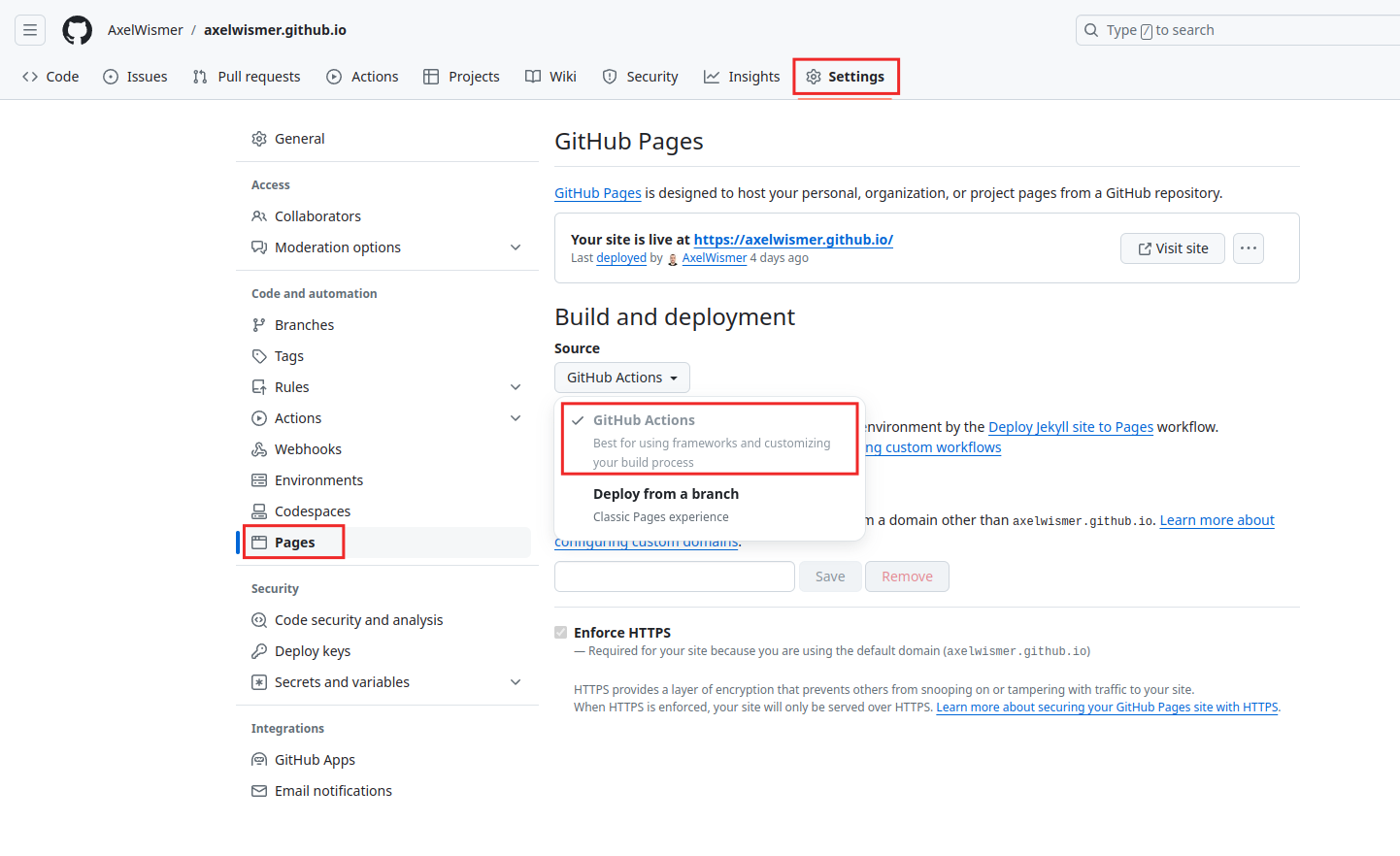Create an SEO Blog with Jekyll

Create an SEO-friendly static Site using Jekyll and GitHub Pages.
Why Jekyll?
When building a website today, there are numerous options available. Popular JavaScript frameworks like React, Angular, and Next.js offer advanced functionality and flexibility but require a strong understanding of frontend design and web technologies. They can also pose challenges for performance and SEO.
On the other hand, low/no-code solutions such as Wix, Builder.io, and Webflow provide excellent templates for starting a fully functional website with ease, though they often come with costs and vendor lock-in.
Jekyll offers a middle ground. As an open-source tool, Jekyll provides a range of templates and plugins that allow you to focus on content creation and design rather than building everything from scratch. It simplifies content creation using Markdown, similar to GitHub’s README.md files, while still supporting HTML, CSS, and JavaScript.
Finding the Right Theme
By default, a new Jekyll project uses the Minima theme. For more personalized themes, explore the community-maintained themes.
For this project, I selected the Hydejack free version. It includes many features out of the box, such as a feed page, an about section, math support, and SEO features.
Fork the GitHub Repo and Set Up GitHub Pages
Visit the theme’s page and fork the repository. Name it {Your GitHub Username}.github.io, e.g., axelwismer.github.io.
Deploy the Site on GitHub Pages
To automate deployment, we use GitHub Actions for continuous integration and delivery. This setup allows us to manage only the Markdown and .yml files, with GitHub Actions handling site generation.
GitHub recognizes that the site uses Jekyll and automatically creates the workflow file. This file configures GitHub to monitor changes to the master branch, install dependencies (gems), and generate static files into the _site folder.
...
on:
# Runs on pushes targeting the default branch
push:
branches: ["master"]
...
jobs:
# Build job
build:
runs-on: ubuntu-latest
steps:
- name: Checkout
uses: actions/checkout@v4
- name: Setup Ruby
uses: ruby/setup-ruby@8575951200e472d5f2d95c625da0c7bec8217c42 # v1.161.0
with:
ruby-version: '3.1' # Not needed with a .ruby-version file
bundler-cache: true # Runs 'bundle install' and caches installed gems automatically
cache-version: 0 # Increment this number if you need to re-download cached gems
- name: Setup Pages
id: pages
uses: actions/configure-pages@v5
- name: Build with Jekyll
# Outputs to the './_site' directory by default
run: bundle exec jekyll build --baseurl "$"
...
Your site will now be deployed on GitHub Pages. To update it, simply push new changes to the main branch.
To clone the repository, use GitHub Desktop or install GitHub CLI and run:
git clone https://github.com/AxelWismer/axelwismer.github.io.git
Installing Jekyll and Ruby
To build and serve the site locally, you’ll need to install Ruby, Bundler, and Jekyll.
Installing Ruby
Ruby is the language used to render Jekyll’s files and install themes through gems.
Find the installation guide for each operating system here. On Ubuntu 20.04.2, I used Snap to install Ruby:
sudo snap install ruby --classic
After installation, verify the Ruby and Gem versions:
ruby -v # ruby 3.3.4 (2024-07-09 revision be1089c8ec) [x86_64-linux]
gem -v # 3.5.11
Installing Bundler
Bundler ensures a consistent environment for Ruby projects by managing gem dependencies.
gem install bundler
bundle -v # Bundler version 2.5.15
Installing Jekyll
gem install jekyll
For the complete installation guide, visit Jekyll’s official site.
Serve the Site in Your Browser
Once everything is installed, you can serve the site locally at localhost:4000 by running:
jekyll serve
For incremental updates (excluding changes to _config.yml) and live reload:
jekyll serve --incremental --livereload
LiveReload address: http://127.0.0.1:35729
Server address: http://127.0.0.1:4000
Server running... press ctrl-c to stop.
Open the provided link in your browser to view the site.
Configuring the Site
You can make general configuration changes in the _config.yml file. The parameters available depend on the template and gems used.
Here’s an example configuration for Search Engine Optimization (SEO) with the jekyll-seo-tag gem:
# Language of your content in 2-letter code, e.g., en, de.
# You may also provide a location, e.g., en-us, de_AT.
lang: en
# The title of your blog. Used in the sidebar and the browser tab.
title: Axel Wismer
# A short description (~150 chars) of the page used for the meta description tag.
# Can use markdown, but no more than one paragraph (enforced by `>`)
description: >
This portfolio showcases my projects in frontend, backend, cloud, cryptography, and smart contracts.
# A shorter description for the sidebar.
tagline: Systems Engineer
# A list of keywords for your blog
keywords: [Axel, Wismer, Systems Engineer, frontend, backend, cloud, GCP, AWS, blockchain, python, js, javascript, smart contract, blog, articles]
# A (square) logo for your site.
# If provided, it will be shown at the top of the sidebar.
# It also used by the `jekyll-seo-tag` plugin.
logo: /assets/img/logo.png
Writing Content
In Jekyll, each page is a single .markdown file that includes the Front Matter and content.
---
layout: post
title: "Create an SEO Blog with Jekyll"
tags: frontend jekyll
sitemap: false
repository: https://github.com/AxelWismer/axelwismer.github.io
image:
path: /assets/img/thumbnail-1920x1080.jpg
srcset:
1920w: /assets/img/blog/jekyll-blog-1920x1080.jpg
960w: /assets/img/blog/jekyll-blog-960x540.jpg
480w: /assets/img/blog/jekyll-blog-480x270.jpg
description: >
Build an SEO static site with Jekyll templates and deploy it on GitHub Pages.
---
# Create an SEO Blog with Jekyll
Content
...
Here is a preview from the feed page (part of the Hydejack template):

The pages are located in the blog/_posts folder in my case.
Handling Images
To insert an image, reference a file in your directories or provide an external link:


Serving local files is preferable as it ensures they are always available and allows for easy modifications.
Editing Images with ImageMagick
I used ImageMagick to modify images, such as resizing, changing formats, or extending backgrounds. I created a script to automate these tasks, so you can replace images and reapply the script as needed.
Here’s an example:
# Resize an image to the correct proportion
convert assets/img/blog/patcat-architecture.png -resize 960x720 -background transparent -gravity center -extent 960x720 assets/img/blog/patcat-architecture@0,5x.png
# Remove background
convert assets/img/logo.png -fuzz 20% -transparent black result.png
# Create icon in .ico format
convert assets/icons/icon.png -resize 140x140 -gravity center assets/icons/favicon.ico
# Convert to multiple sizes
convert assets/icons/icon.png -resize 512x512 -background transparent -gravity center assets/icons/icon-512x512.png
convert assets/icons/icon.png -resize 384x384 -background transparent -gravity center assets/icons/icon-384x384.png
convert assets/icons/icon.png -resize 192x192 -background transparent -gravity center assets/icons/icon-192x192.png
...
Embedding Videos
To embed a video, create an HTML file in the _includes folder with reusable snippets:
<!-- source: https://github.com/nathancy/jekyll-embed-video -->
<video controls>
<source src="">
Your browser does not support the video tag.
</video>
Include it in your post with:
{% include video.html id="https://user-images.githubusercontent.com/49920097/206914537-8491be30-90f3-4940-bc67-e5427cbdaadf.mp4" %}
For instance, here is an embedded video from my project ECDSA Node:
That’s it! You now have a static blog with a modern look deployed for free on GitHub Pages. For more examples, check out the rest of my Blog, or view the code for this project on my Repo.
